This post contains affiliate links.
Most people who regularly drink commercial Kombucha do not know that the Kombucha they are drinking is actually Kombucha soda. The Kombucha that was consumed for thousands of years was just fermented sweet tea and consumed without any form of second fermentation which we do today.
Second fermentation carbonates the Kombucha, adds flavors and increases its shelf life. Through the second fermentation process the flavor of Kombucha can take on any flavor you can imagine.
Flavor Kombucha with store bought fruit juice
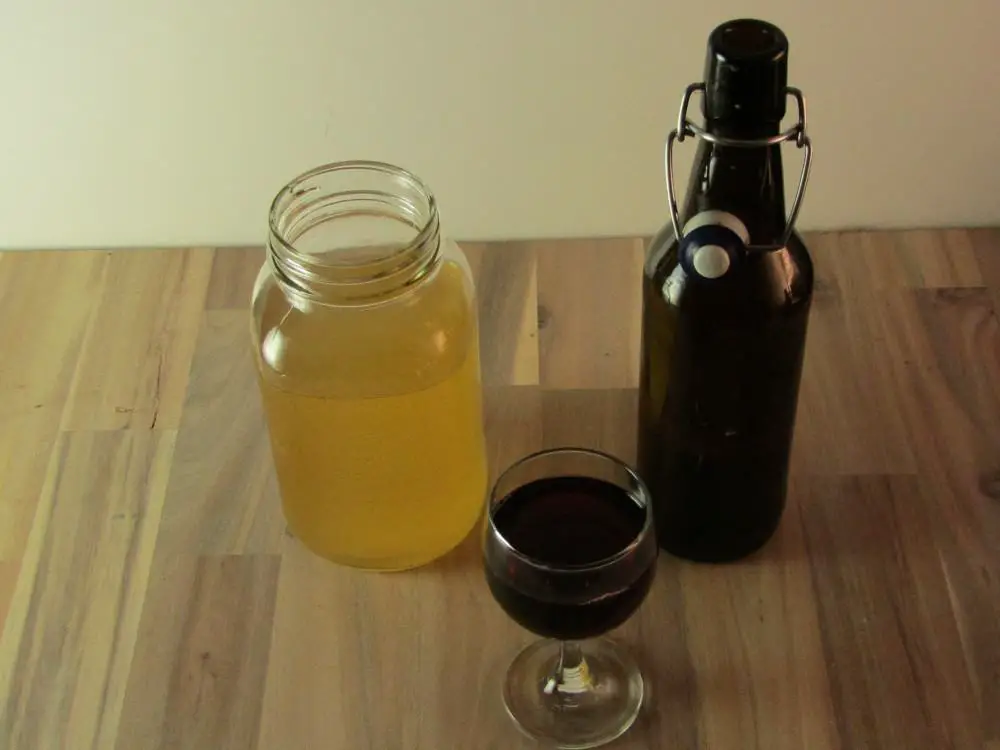
This is one of the easiest ways to flavor your Kombucha. You can use any type of fruit juice as all commercial fruit juice has lots of easily fermentable sugars. Try the usual grape, apple, strawberry, pineapple and mixed varieties often called fruit medalies.
How to use commercial fruit juice for second fermentating Kombucha
- Fill the bottle ¾ full with plain Kombucha
- Top up the bottle with the fruit juice of your choice leaving a bit of headroom
- Cap the bottles and leave them in a warm location out of the sun for 4-7 days
- After four days check one bottle for carbonation
- Once the desired carbonation has been reached refrigerate to slow further fermentation
When choosing a fruit juice you will get the best results with juices which don’t have a lot of preservatives as these can slow the growth of the microorganisms in the second fermentation leading to longer fermentation times. The most common food preservatives used in fruit juices are:
potassium sorbate
Potassium sorbate has been used for 200 years. It is used to prevent mold and yeast growth but is not as effective in inhibiting lactic acid bacteria which will continue to convert the sugar in the juice into CO2 which carbonates the Kombucha. Potassium sorbate will slow the process of second fermentation somewhat but the Kombucha will still carbonate.
Sodium benzoate
Sodium benzoate is more effective on bacterial strains than potassium sorbate. It is used to inhibit the growth of mold, yeast and bacteria in food. The fact that it inhibits the growth of both yeast and bacteria make it detrimental to the Kombucha culture when juice using this preservative is used. Sodium benzoate will slow the carbonation process of your Kombucha, adding a few days to the carbonation process.
Frozen juice has less preservatives as it is the freezing process which is being used to extend the shelf life of the juice. These types of juice are great for adding a strong flavor to your Kombucha as these juices come concentrated. Only a small amount of the concentrate is needed to flavor and add enough extra sugar to the Kombucha for its second fermentation.
Any type of commercially prepared fruit juice can be used including:
- Apple
- Grape
- Mango
- Pineapple
- Cranberry
- Strawberry
- Fruit medalies of various fruits
Flavor Kombucha with freshly made fruit juice
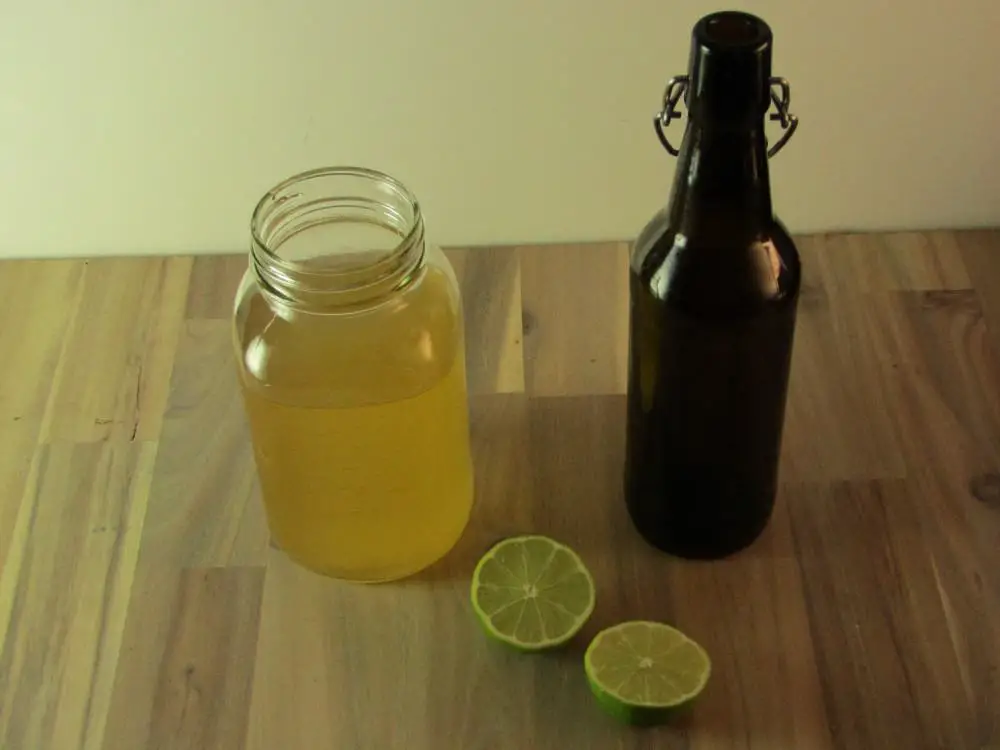
Freshly made fruit juice is not only high in sugar but also carries the benefits of the fresh fruit into the Kombucha. Any type of sweet fruit can be used without adding any additional sugar for the yeast and lactic acid bacteria to use during the carbonation process.
Citrus fruits
Citrus fruits such as oranges or grapefruit can be squeezed using a citrus juicer. They provide good flavors to your Kombucha as the tangy citrus flavor goes well with the tangy lactic acid flavor in the Kombucha. Use about a ¼ cup citrus juice per bottle of Kombucha and be sure to check the carbonation level regularly to avoid over carbonation.
Hard fruits
These types of fruits need a fruit and vegetable juicer. These juicers come in all shapes and sizes as well as price points. If you have access to one of these types of juicers then making juice for second fermenting your Kombucha is a great use for it. If you are going to make kombucha regularly with hard fruits then it is a good idea to purchase a juicer, they have many other uses beyond making kombucha such as making fruit vinegars. Don’t have a juicer? Check prices on Amazon here.
Any type of fresh hard fruits can be used to flavor your Kombucha such as apples, pears and peaches.
How to use freshly made fruit juice for second fermenting Kombucha
- Prepare the fruit for juicing depending on the type of juice you are making.
- Run the fruit through the juicer to make enough to fill each bottle ¼ full
- Fill the bottles ¾ full of kombucha
- Top up the bottles with the fresh juice leaving some headroom
- Place the bottles in a warm location out of the sun
- Ferment for 3-7 days
- Begin testing for carbonation after 3 days
- Once it is carbonated to your liking refrigerate to slow fermentation
Flavor Kombucha with whole fruit
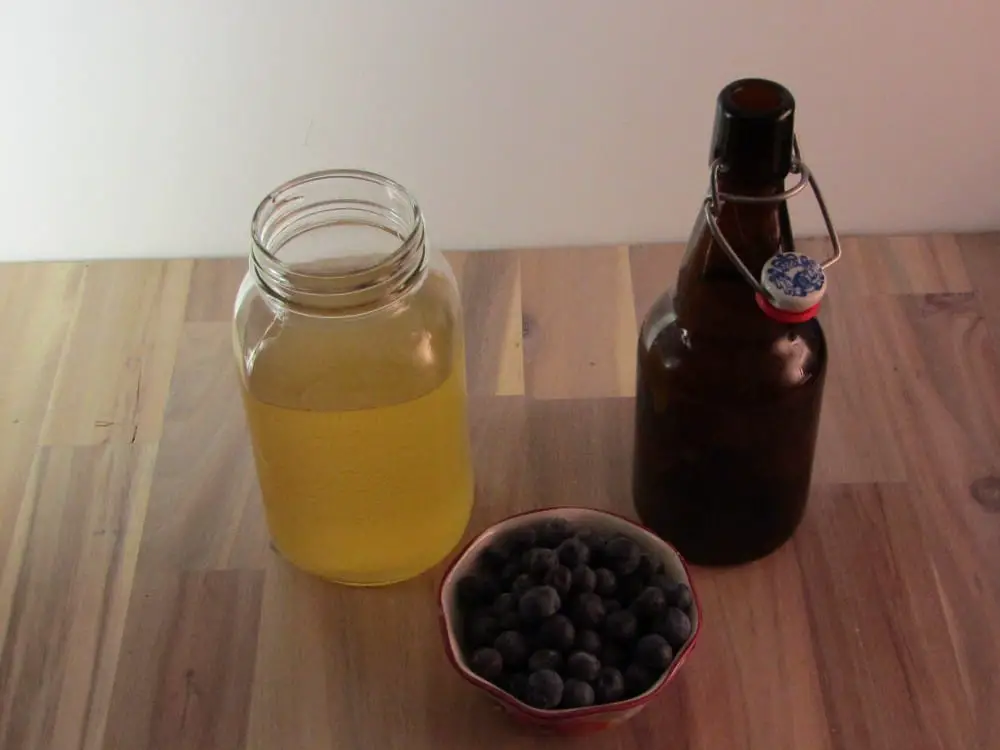
Whole fruit can be used as well. This is a great way to use small berries in the second fermentation process such as blueberries, elderberries and blackberries. You can also chop up larger fruits into small pieces to allow them to go through the neck of the bottle.
The use of whole fruit adds food value to the Kombucha while supplying enough sugar for the culture to carbonate the Kombucha. Any dark colored fruit adds tannins which have health benefits as well as adding flavor and texture.
When using whole fruit cut the fruit into small pieces to give easy access to the sugar in the fruit. This will shorten the fermentation time while allowing all the flavor of the fruit to premiate the Kombucha. Another way of adding fresh whole fruit to the second fermentation is to blend it up in a high powered blender. This liquifies the fruit and helps the flavor to permeate the Kombucha soda.
How to use whole fruit for second fermenting Kombucha
There are two methods you can use:
Cut the fruit into small pieces
- Either cut large fruit into small enough pieces to easily pass through the neck of the bottles you are using or use small fruit like berries which can pass through whole.
- Put ¼ cup or so of fruit into each bottle
- Fill the bottle with Kombucha leaving some headroom
- Place the bottles in a warm location out of the sun to ferment
- Ferment for 3-7 days then begin checking for adequate carbonation
- Once your Kombucha is carbonated to your liking move to the refrigerator to slow fermentation.
Blend the fruit
- Remove any hard pits or unwanted cores of the fruit and put into the blender
- Add two cups of Kombucha to the blender
- Blend on high for a minute
- Fill the bottles ⅔ full of Kombucha
- Top up the bottles with the blended fruit Kombucha mix
- Ferment for 3-7 days then begin checking for adequate carbonation
- Move to the refrigerator once it is carbonated enough for you
Flavor Kombucha with vegetable juice
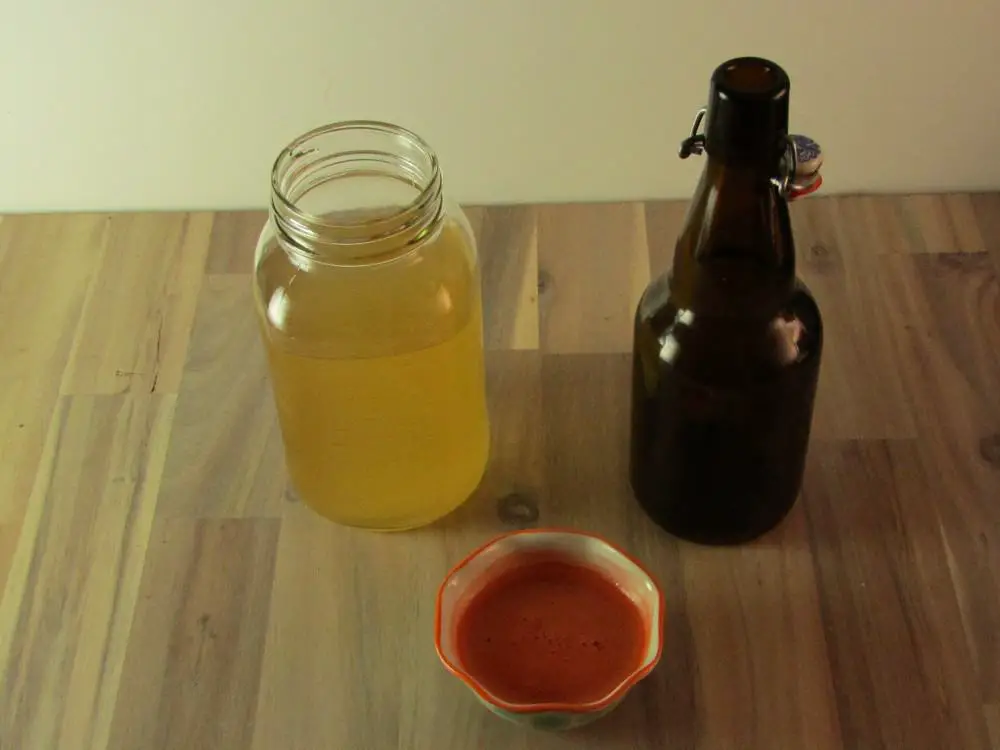
Some vegetables are high in fermentable sugars which can feed the lactic acid bacteria and yeast to produce CO2. Root vegetables are good ones to start with as they are high in sugar and have flavors which can go very well with Kombucha.
You will need a good vegetable juicer which can remove most of the liquid in the vegetables leaving a very dry pulp. These can be found at kitchen supply stores, health food stores or online. If you plan on using a juicer regularly, get a good quality one as the cheaper versions are hard to clean, don’t make as much juice and can break easily.
Some vegetables to try:
- Carrot
- Beet
- Parsnip
- Radishes
- Fresh Corn
- Fresh Peas
Each of the above vegetables are high in fermentable sugar content providing the Kombucha culture with enough energy to carbonate in the bottle. Other vegetables like cabbage, broccoli and onions have enough fermentable sugar but may conflict with the flavor of the Kombucha. Try them if you are adventurous but don’t be afraid to pitch a bottle or two if the flavor is not good.
How to use vegetables for second fermenting Kombucha
- Cut the vegetables into small enough pieces to fit through the juicer
- Juice enough vegetables to fill the bottles ¼ full
- Fill the bottles ¾ full with Kombucha
- Top up the bottles with the freshly made vegetable juice leaving some headroom
- Place the bottles in a warm location out of the sun
- Ferment for 3-7 days
- Begin checking for adequate carbonation after day three
- Once it is carbonated to your liking refrigerate to slow fermentation
Flavor Kombucha with Ginger or Tumeric
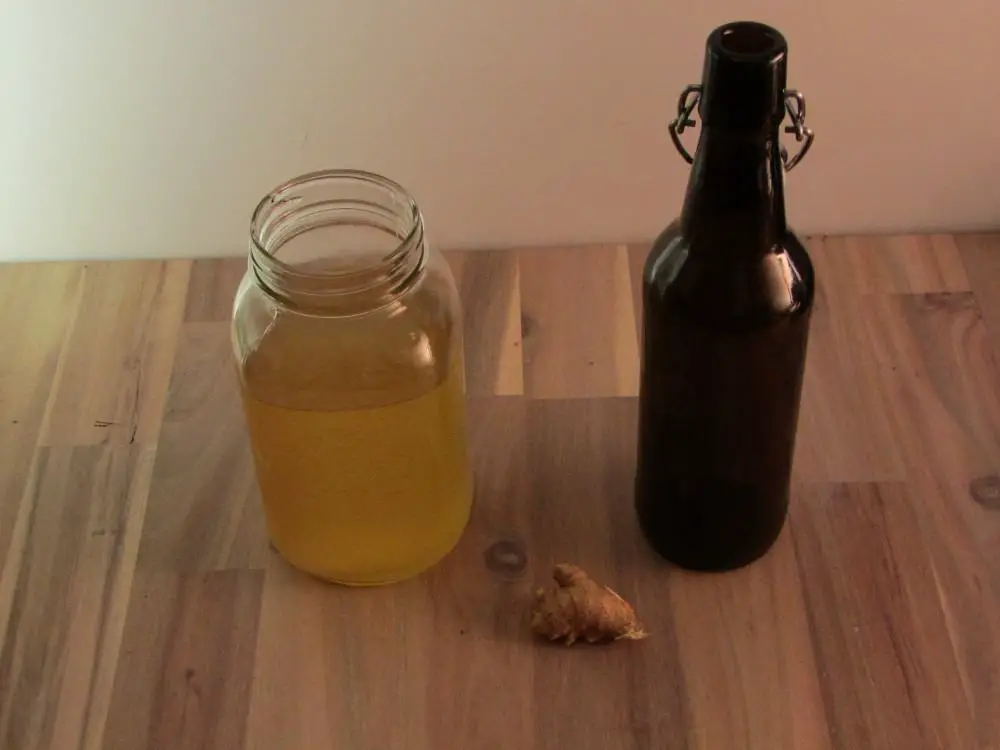
Ginger and turmeric are in a special category as they are considered a spice as well as a vegetable. They are officially rhizomes which are root like formations which when planted can regrow the plant. This is how ginger and turmeric are propagated.
Both ginger and turmeric are high in sugar but also have many proven health benefits. When they are used to flavor Kombucha they carry these benefits through into the soda improving the positive effect Kombucha has on your body.
One thing to be aware of is the carbonation power ginger and turmeric have on Kombucha. A little goes a long way when using these two in a second ferment. You can use any type of ginger or turmeric, fresh, powdered or juiced. The flavor is strong and can be quite spicy if enough is used.
How to use ginger and turmeric for second fermenting Kombucha
There are three ways you can flavor your Kombucha with ginger or turmeric (maybe more).
Use powdered ginger and/or tumeric
- Fill the bottles with Kombucha leaving some headroom
- Add ¼ tsp of ginger or turmeric to each bottle
- Add a one tsp of white sugar to each bottle
- Place bottles in a warm dark location
- Ferment for 3-7 days
- Begin checking for carbonation after day three
- Refrigerate after carbonation is to your liking
Use fresh
- Chop the ginger and/or turmeric into pieces small enough to fit through the neck of the bottles
- Place one or two pieces into each bottle
- Fill the bottles with Kombucha leaving some headroom
- Place bottles in a warm dark location
- Ferment for 3-7 days
- Begin checking for carbonation after day three
- Refrigerate after carbonation is to your liking
Juice fresh rhizomes and use the juice
- Juice the ginger and/or turmeric in a vegetable juicer
- Fill the bottles with Kombucha leaving a little more headroom than usual
- Divide the fresh juice between the bottles
- Place bottles in a warm dark location
- Ferment for 3-7 days
- Begin checking for carbonation after day three
- Refrigerate after carbonation is to your liking
Use dried or fresh herbs
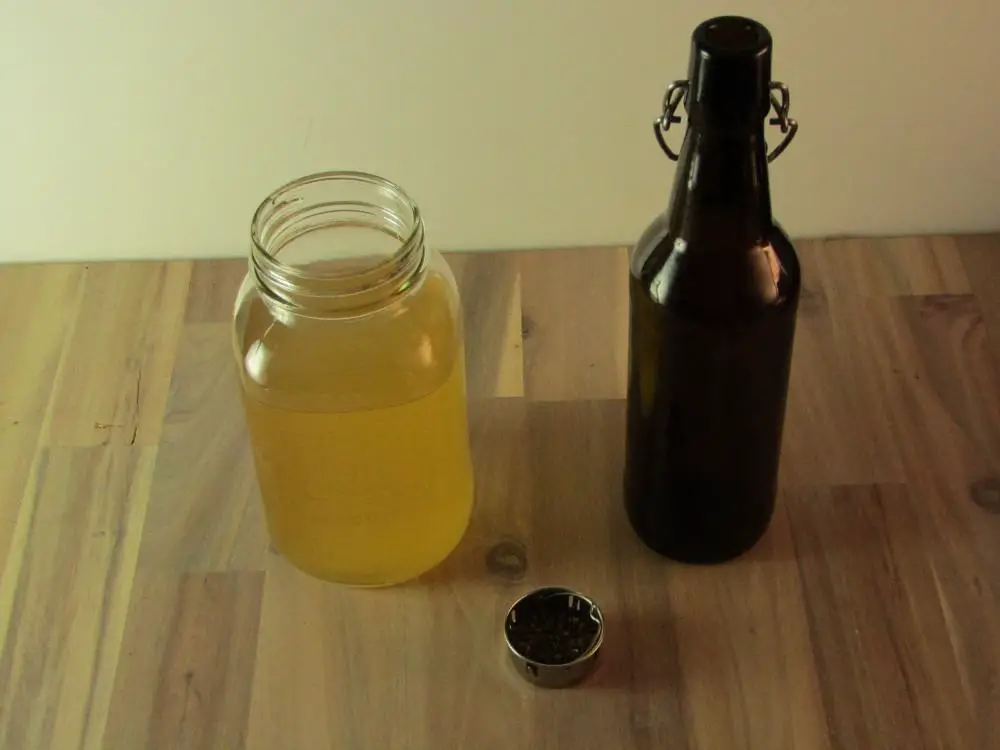
Spices like cinnamon, peppermint and cardamom can also be used to flavor Kombucha. The combinations you can try are unlimited, especially with the availability of dried spices from all over the world. You could try herb combinations including licorice and cinnamon or single flavors such as hibiscus or sassafras.
If you can get fresh herbs they can be added directly into the bottle before filling them with Kombucha. Add small amounts and judge the flavor after carbonation, then you can determine if you want more flavor. Once your Kombucha is flavored you cannot go back.
When using dried herbs to flavor Kombucha use small amounts for each bottle as the spices are very concentrated and can easily overwhelm the Kombucha soda. It is also important to add a little sugar to each bottle to provide additional energy for the lactic acid bacteria and yeast to produce the CO2 needed for carbonation.
How to use dried or fresh herbs for second fermenting Kombucha
- Add small amounts of the spice to each bottle
- Add one tsp of white sugar to each bottle
- Fill the bottles with Kombucha leaving a little headroom
- Shake the bottles to help the sugar to dissolve
- Place the bottles in a warm dark location
- Ferment for 3-7 days
- Begin checking for carbonation after day three
- Refrigerate after carbonation is to your liking
Use tree syrup
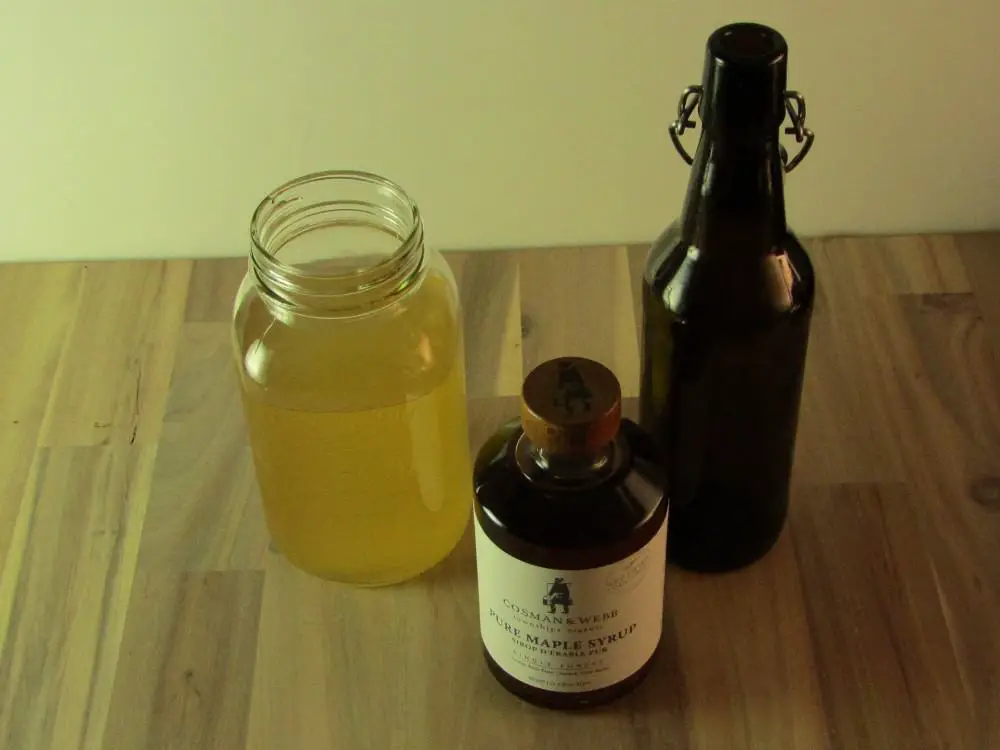
Tree syrup is another source of fermentable sugar which can add additional flavor to your Kombucha soda. The usual maple syrup is a good choice as it has lots of flavor with a smoky aftertaste and is readily available in stores.
Birch and palm syrup can be found in speciality stores or if you are adventurous you could tap your own trees. Any maple tree can be tapped as well as walnut, alder and sycamore. The process requires tapping the trees, collecting the sap and reducing the water content of the sap to concentrate the sugar.
If you want to try flavoring your Kombucha with tree syrup begin with readily available syrups and experiment from there.
How to use tree syrup for second fermenting Kombucha
- Pour the fermented Kombucha into a container leaving some for the next batch
- Add one tsp of syrup for each bottle of kombucha you are making
- Stir until the syrup is incorporated into the Kombucha
- Fill the bottles with the syrup Kombucha mixture
- Place the bottles in a warm dark location
- Ferment for 3-7 days
- Begin checking for carbonation after day three
- Refrigerate after carbonation is to your liking
Use Molasses
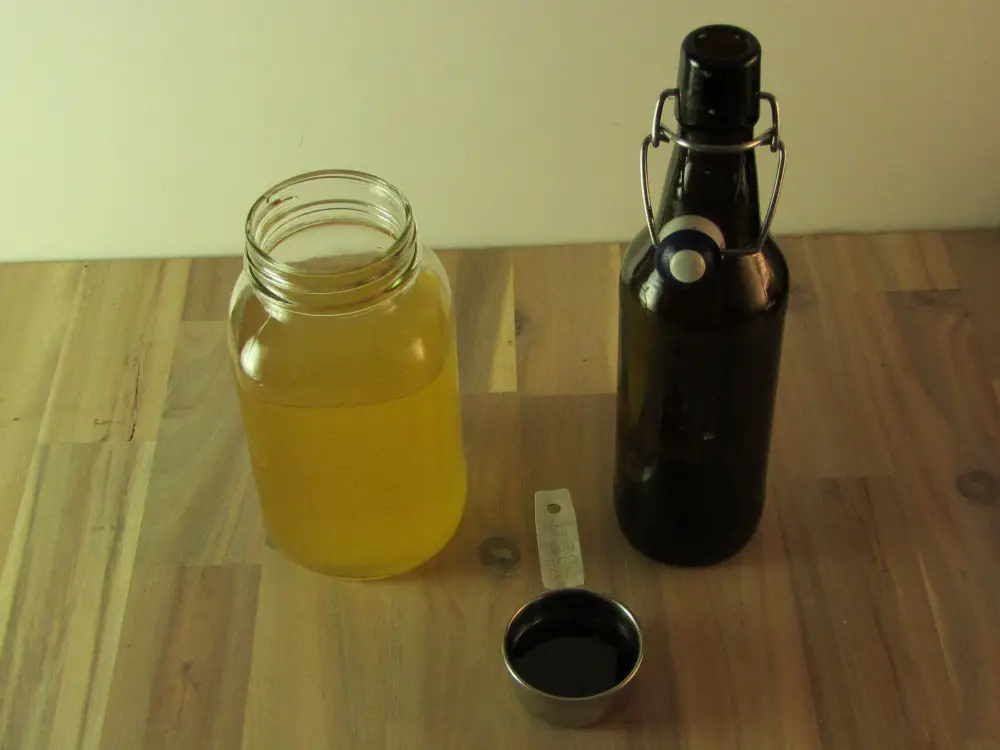
Molasses is the syrup left after making white sugar. It is full of minerals and has a strong smoky flavor which adds another level of interest to Kombucha. Molasses comes in a variety of types from light to blackstrap and gets progressively stronger flavored and less sweet. Avoid sulfured molasses as it will inhibit the growth of the lactic acid bacteria and yeast as well as adding a chemical flavor to the Kombucha.
When flavoring with molasses start with the lightest type you can find. Once you have made a few batches and you like the result try a stronger flavored molasses. You can also add other flavors which go with molasses such as ginger for another level or flavoring.
How to use molasses for second fermenting Kombucha
- Pour the fermented Kombucha into a container leaving some for the next batch
- Add one tsp of molasses for each bottle of kombucha you are making
- Stir until the molasses is incorporated into the Kombucha
- Fill the bottles with the molasses Kombucha mixture
- Place the bottles in a warm dark location
- Ferment for 3-7 days
- Begin checking for carbonation after day three
- Refrigerate after carbonation is to your liking
Use plain sugar
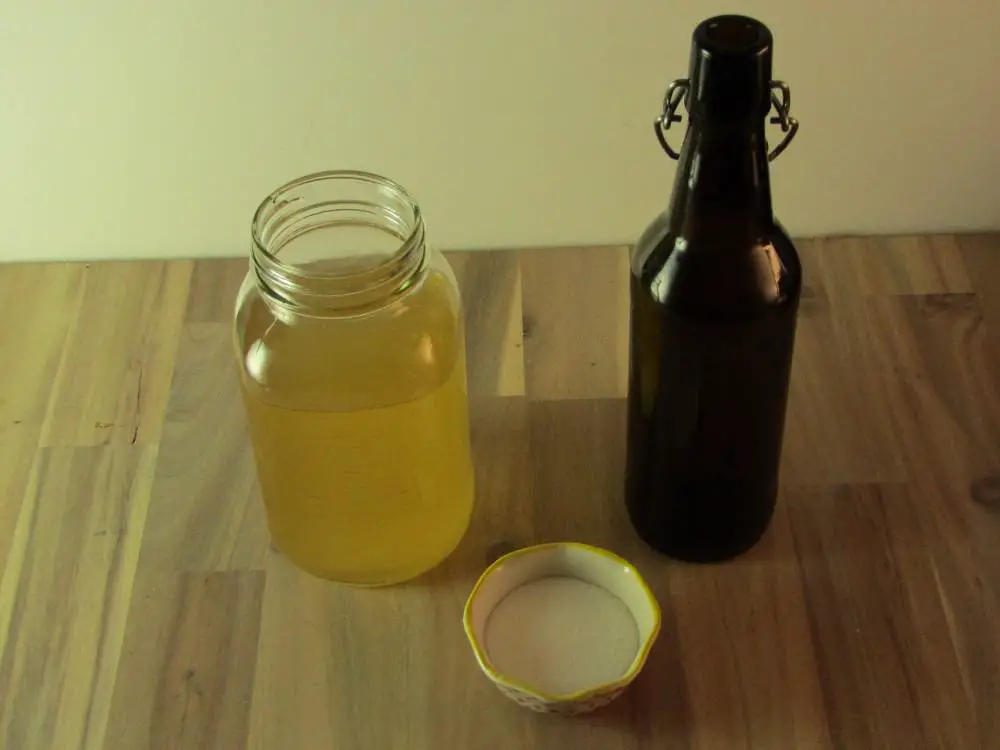
Kombucha with no added flavor is another great choice. The flavor of the tea which you used to make the Kombucha comes through so try a variety of teas of different types. There are lots of different types of tea even though they all come from the same plant (Camellia sinensis). Each type of tea provides a different flavor which is noticeable when other flavors are not added during second fermentation.
Teas from the Camellia sinensis plant for making Kombucha
Black teas to try
- Assam
- Darjeeling
- Ceylon
- Lapsang Souchong
- English breakfast
Oolong teas to try
- Tieguanyin
- Jin Xua
- Da Hong Pao
- Tung-ting
- Baozhong
White teas to try
- Baihao
- White Peony
- Silver Needle
- Long life eyebrow
- Tribute Eyebrow
Green teas to try
- Sencha
- Gyokuro
- Genmaicha
- Longjing
- Gunpowder
- Hōjicha
- Bancha
Stay away from tea which has essential oils added as they can be bitter and unpleasant.
Herb teas may not have any caffeine in them which is a typical Kombucha ingredient but they still have lots of tannins and other flavor components. Using herbal tea without any flavoring provides additional flavors which are difficult to produce any other way.
The list of herbal teas is endless, all of which have their own characteristics, benefits and flavors. Combinations of herbal teas also add to the varieties you can make.
Some herbal teas to try
- Peppermint
- Licorice
- Chamomile
- Rosehip
- Rooibos
- Cinnamon
- Tulsi (holy basil)
- Rosemary
How to use plain sugar for second fermentation of Kombucha
- Pour off the amount of Kombucha you are ready to second ferment into another container
- Add one tsp of sugar per bottle you are making
- Stir to dissolve the sugar
- Fill and cap the bottles
- Place the bottles in a warm dark location
- Ferment for 3-7 days
- Begin testing for adequate carbonation on day 3
- Once it is carbonated to you liking refrigerate to slow fermentation
Use flavor extracts
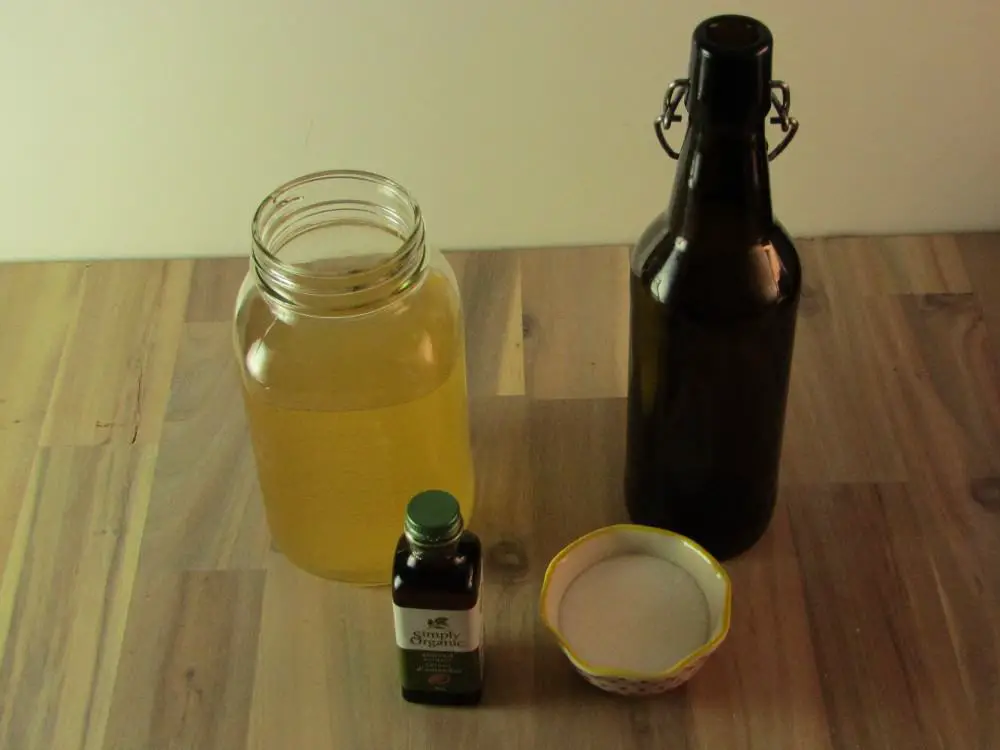
Flavor extracts can be found in the bakery section of most grocery stores. They can be added to the kombucha after the first ferment to add interesting flavors to the Kombucha. With flavor extracts you don’t even need to second ferment the Kombucha if you don’t want to. Instead just pour some into a glass, add a little flavor extract of your choice and drink it.
Flavor extracts are usually alcohol based which provides the acetic acid bacteria with a little fuel but as the carbonation process requires an anaerobic environment they have little chance to use the alcohol and produce much CO2. Instead sugar needs to be added to feed the lactic acid bacteria and yeast.
Some flavors to try
- Butterscotch
- Carmel
- Rosemary
- Almond
- Ameraeto
- Vanilla
- Brandy
- Chocolate
- Coconut
- Rum
How to use flavor extracts for second fermentation of Kombucha
- Pour off the Kombucha you are going to second ferment
- Add a little flavor extract at a time and taste it after each addition
- Once you have reached the desired flavor add one tsp of sugar for every bottle of Kombucha you are making
- Cap the bottles and place in a warm location out of direct light
- Ferment for 3-7 days
- Begin checking the carbonation level after day three
- Once adequate carbonation has been reached refrigerate the Kombucha to slow fermentation
Additional more adventurous methods of flavoring Kombucha
The different ways of flavoring Kombucha is endless and if you are reading this section you must have noticed the repetition in how each of the above methods are accomplished. This section will give you some ideas for flavorings which normally would be considered strange but once you try a few of them you will be able to come up with some of your own.
Start with coffee for the first ferment rather than tea
Simply replace the tea leaves with coffee grounds when making the liquid for the first ferment. Once it has finished the primary fermentation you can add additional flavorings if you like.
Some second fermentation flavors to try
- Vanilla extract
- Butterscotch extract
- Cocoa powder
Use tree sap rather than water for making the tea
Rather than using water to make the tea use some fresh tree sap. Tree sap can only be collected during certain times of the year so this limits the time frame for this type of flavoring but in the spring it can be an interesting experiment.
You will need
- access to tappable trees
- A spile
- A bucket
- A drill with a drill bit
The tree sap will have a little sugar in it but not nearly enough to feed the Kombucha culture so you will have to add some white sugar for the first ferment.
Use hot peppers for the second ferment
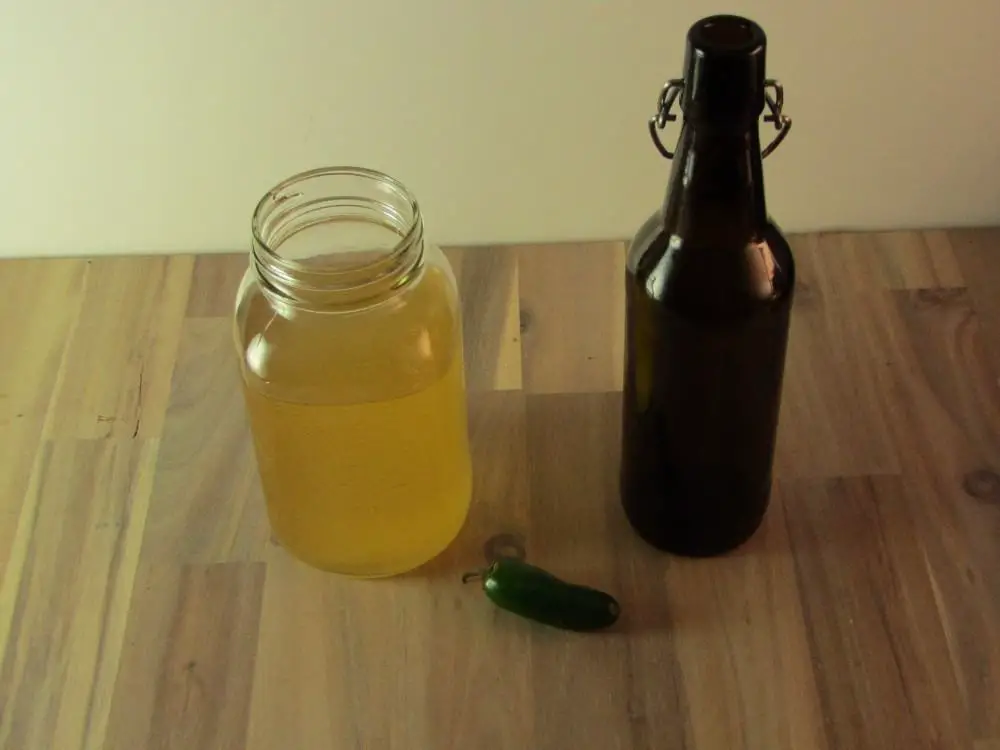
There are many types of hot peppers which all have different levels of heat, flavor and color. They can be added to the second fermentation just like any other fruit. They are high in sugar but because of their spicy nature you will not want to add to many. This means you will have to add a little sugar before bottling your spicy Kombucha.
Things to know about hot peppers
- The heat in the pepper is in the white pith which the seeds are attached to so if you want more flavor but less heat remove as much of this pith as possible.
- The fermentation process increases the spice level of the peppers so the longer they ferment the hotter the Kombucha soda will be.
- Each type of pepper has a different level of heat so be selective in the type you choose for the result you want.
Use honey to sweeten the first ferment
Honey can be used to sweeten the Kombucha during the first ferment. In fact if you use green tea and honey for the first ferment the result will be Jun tea which is considered a high end beverage all its own.
Jun tea is usually not second fermented but rather consumed plain after the first ferment. It has a wonderfully smooth flavor and highlights the type of tea you used.
Flavor the second ferment with hops
Hops are a flavoring usually associated with beer or hopped ciders but they can also add depth of flavor to your Kombucha. They add a slightly bitter flavor to whatever they are added to so use them sparingly for the first few times and adjust how much to use as you go.
Ways to use hops to flavor Kombucha
- Boil the hops with water and sugar to make a light syrup to use for the second fermentation
- Add some hops directly into each bottle of Kombucha.
- Blend a few ounces of hops with some kombucha and divide the mixture between the bottles.


